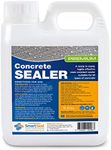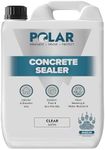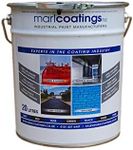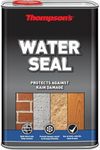Buying Guide for the Best Concrete Sealers
Choosing the right concrete sealer is crucial for protecting and enhancing the appearance of your concrete surfaces. Whether you're sealing a driveway, patio, or indoor concrete floor, the right sealer can prevent damage from water, chemicals, and wear, while also improving the aesthetic appeal. To make the best choice, consider the specific needs of your project, such as the location, exposure to elements, and desired finish. Understanding the key specifications of concrete sealers will help you select the most suitable product for your needs.Type of SealerConcrete sealers come in various types, including penetrating sealers, acrylic sealers, epoxy sealers, and polyurethane sealers. Each type serves a different purpose. Penetrating sealers are ideal for outdoor surfaces as they protect against moisture and deicing salts without altering the appearance. Acrylic sealers are versatile and can be used both indoors and outdoors, providing a glossy finish and UV protection. Epoxy sealers are best for indoor use, offering a durable and glossy finish, while polyurethane sealers provide a high-gloss finish and are resistant to chemicals and abrasion. Choose the type based on where the concrete is located and the level of protection and finish you desire.
FinishThe finish of a concrete sealer can range from matte to high-gloss. A matte finish provides a natural look, making it suitable for areas where you want to maintain the original appearance of the concrete. A satin or semi-gloss finish offers a slight sheen, enhancing the color and texture of the concrete without being too reflective. High-gloss finishes are very shiny and can make colors pop, but they may also highlight imperfections. Consider the aesthetic you want to achieve and the condition of the concrete surface when choosing the finish.
DurabilityDurability refers to how well the sealer can withstand wear and tear, exposure to elements, and chemical spills. For outdoor surfaces exposed to harsh weather, a highly durable sealer like a penetrating or polyurethane sealer is recommended. For indoor surfaces with less exposure to elements, an acrylic or epoxy sealer may suffice. Consider the level of foot or vehicle traffic the area will experience and choose a sealer that can handle the expected wear.
Application MethodConcrete sealers can be applied using different methods such as rolling, brushing, or spraying. The application method can affect the ease of use and the final appearance of the sealer. Rolling is common for large, flat surfaces and provides an even coat. Brushing is suitable for small areas or detailed work, while spraying can cover large areas quickly and is ideal for uneven surfaces. Consider the size and shape of the area you are sealing and choose a method that will provide the best coverage and finish.
Drying TimeDrying time is the period it takes for the sealer to cure and be ready for use. This can range from a few hours to several days, depending on the type of sealer and environmental conditions. Quick-drying sealers are convenient for projects that need to be completed quickly, while longer drying times may be necessary for thicker or more durable sealers. Consider your project timeline and the conditions in which you are applying the sealer when evaluating drying time.

















